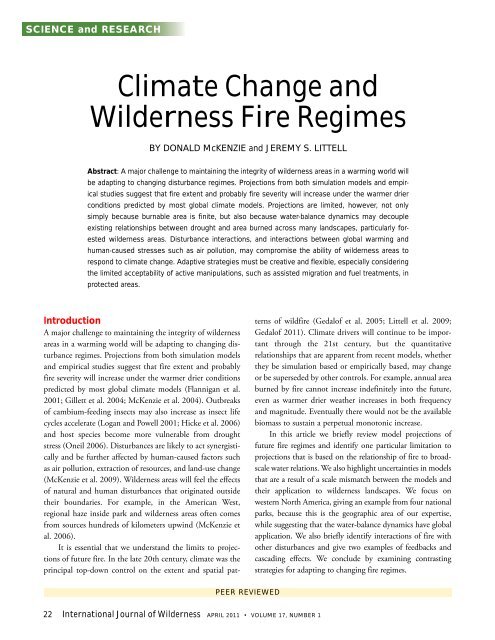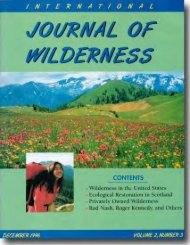Download April 2011 PDF - International Journal of Wilderness
Download April 2011 PDF - International Journal of Wilderness
Download April 2011 PDF - International Journal of Wilderness
Create successful ePaper yourself
Turn your PDF publications into a flip-book with our unique Google optimized e-Paper software.
SCIENCE and RESEARCH<br />
Climate Change and<br />
<strong>Wilderness</strong> Fire Regimes<br />
BY DONALD McKENZIE and JEREMY S. LITTELL<br />
Abstract: A major challenge to maintaining the integrity <strong>of</strong> wilderness areas in a warming world will<br />
be adapting to changing disturbance regimes. Projections from both simulation models and empirical<br />
studies suggest that fire extent and probably fire severity will increase under the warmer drier<br />
conditions predicted by most global climate models. Projections are limited, however, not only<br />
simply because burnable area is finite, but also because water-balance dynamics may decouple<br />
existing relationships between drought and area burned across many landscapes, particularly forested<br />
wilderness areas. Disturbance interactions, and interactions between global warming and<br />
human-caused stresses such as air pollution, may compromise the ability <strong>of</strong> wilderness areas to<br />
respond to climate change. Adaptive strategies must be creative and flexible, especially considering<br />
the limited acceptability <strong>of</strong> active manipulations, such as assisted migration and fuel treatments, in<br />
protected areas.<br />
Introduction<br />
A major challenge to maintaining the integrity <strong>of</strong> wilderness<br />
areas in a warming world will be adapting to changing disturbance<br />
regimes. Projections from both simulation models<br />
and empirical studies suggest that fire extent and probably<br />
fire severity will increase under the warmer drier conditions<br />
predicted by most global climate models (Flannigan et al.<br />
2001; Gillett et al. 2004; McKenzie et al. 2004). Outbreaks<br />
<strong>of</strong> cambium-feeding insects may also increase as insect life<br />
cycles accelerate (Logan and Powell 2001; Hicke et al. 2006)<br />
and host species become more vulnerable from drought<br />
stress (Oneil 2006). Disturbances are likely to act synergistically<br />
and be further affected by human-caused factors such<br />
as air pollution, extraction <strong>of</strong> resources, and land-use change<br />
(McKenzie et al. 2009). <strong>Wilderness</strong> areas will feel the effects<br />
<strong>of</strong> natural and human disturbances that originated outside<br />
their boundaries. For example, in the American West,<br />
regional haze inside park and wilderness areas <strong>of</strong>ten comes<br />
from sources hundreds <strong>of</strong> kilometers upwind (McKenzie et<br />
al. 2006).<br />
It is essential that we understand the limits to projections<br />
<strong>of</strong> future fire. In the late 20th century, climate was the<br />
principal top-down control on the extent and spatial pat-<br />
PEER REVIEWED<br />
22 <strong>International</strong> <strong>Journal</strong> <strong>of</strong> <strong>Wilderness</strong> APRIL <strong>2011</strong> VOLUME 17, NUMBER 1<br />
terns <strong>of</strong> wildfire (Gedal<strong>of</strong> et al. 2005; Littell et al. 2009;<br />
Gedal<strong>of</strong> <strong>2011</strong>). Climate drivers will continue to be important<br />
through the 21st century, but the quantitative<br />
relationships that are apparent from recent models, whether<br />
they be simulation based or empirically based, may change<br />
or be superseded by other controls. For example, annual area<br />
burned by fire cannot increase indefinitely into the future,<br />
even as warmer drier weather increases in both frequency<br />
and magnitude. Eventually there would not be the available<br />
biomass to sustain a perpetual monotonic increase.<br />
In this article we briefly review model projections <strong>of</strong><br />
future fire regimes and identify one particular limitation to<br />
projections that is based on the relationship <strong>of</strong> fire to broadscale<br />
water relations. We also highlight uncertainties in models<br />
that are a result <strong>of</strong> a scale mismatch between the models and<br />
their application to wilderness landscapes. We focus on<br />
western North America, giving an example from four national<br />
parks, because this is the geographic area <strong>of</strong> our expertise,<br />
while suggesting that the water-balance dynamics have global<br />
application. We also briefly identify interactions <strong>of</strong> fire with<br />
other disturbances and give two examples <strong>of</strong> feedbacks and<br />
cascading effects. We conclude by examining contrasting<br />
strategies for adapting to changing fire regimes.










